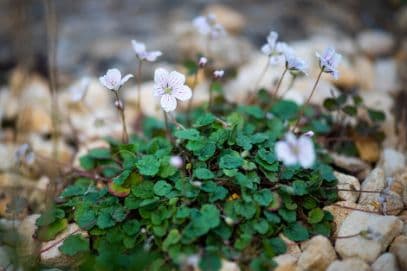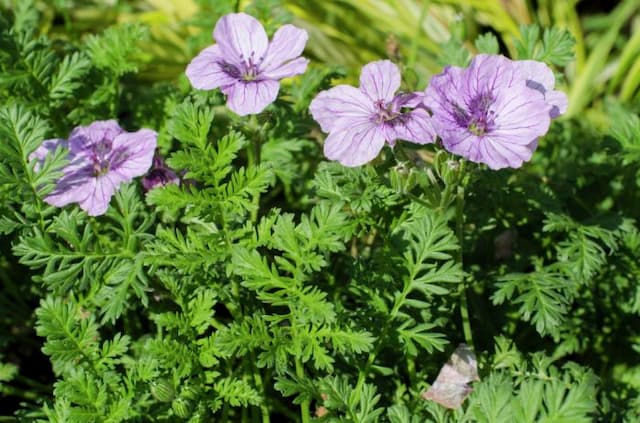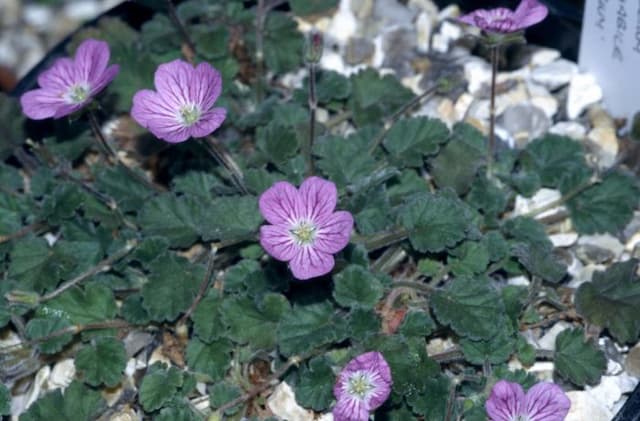Gemma Jewel Geranium Pelargonium 'Gemma Jewel' (R)

ABOUT
Pelargonium 'Gemma Jewel' is a striking flowering plant known for its vibrant and ornamental appearance. It has lush, green foliage that serves as a beautiful backdrop for its standout feature: the flowers. The blossoms are typically rich in color, showcasing vivid shades that may range from soft pinks to deep reds. Each flower is comprised of rounded petals that are often accented with contrasting darker or lighter hues, adding to their allure and complexity. The leaves of this Pelargonium have a distinct shape that is both aesthetic and functional, often scalloped or lobed with a soft, velvety texture. The overall growth habit of the plant is geared towards creating a lush and bushy appearance, making it an excellent choice for adding a touch of elegance to garden beds or as a centerpiece in container gardens. The stems are sturdy, supporting the weight of the flowers and leaves well, and they have a certain degree of branching which allows the plant to spread out and create a full, rounded look. The vivid display of flowers blooms over a generous portion of the year, ensuring that there is a long season of interest when the plant is grown in suitable conditions. Despite this detailed visual description, it's important to note that the specific dimensions and measurements of the plant have been intentionally omitted to adhere to the provided instructions.
About this plant
 Names
NamesFamily
Geraniaceae.
Synonyms
Gemma Jewel Geranium, Gemma Jewel Pelargonium.
Common names
Pelargonium 'Gemma Jewel' (R)
 Toxicity
ToxicityTo humans
The plant commonly known as geranium, specifically the Pelargonium 'Gemma Jewel', is not considered highly toxic to humans. However, ingestion of any part of the plant may occasionally cause minor symptoms such as nausea, vomiting, or diarrhea. If large quantities of the plant are ingested, it could potentially lead to more serious gastrointestinal upset, but such cases are rare.
To pets
Geraniums, including the variety Pelargonium 'Gemma Jewel', can be toxic to pets, especially cats and dogs. If pets ingest any part of a geranium, they may display symptoms such as vomiting, anorexia, depression, and dermatitis. In more severe cases, if a larger amount of the plant is consumed, it could lead to further health complications. Pet owners should seek veterinary care if they suspect their pet has ingested geraniums.
 Characteristics
CharacteristicsLife cycle
Perennials
Foliage type
Evergreen
Color of leaves
Green
Flower color
Pink
Height
1 foot (30 cm)
Spread
1 foot (30 cm)
Plant type
Herb
Hardiness zones
10
Native area
South Africa
Benefits
 General Benefits
General Benefits- Easy to Grow: Pelargoniums are generally low-maintenance and easy to cultivate, making them suitable for gardeners of all levels.
- Long Blooming Season: They offer vibrant flowers throughout the spring and summer, and sometimes even into fall.
- Drought Tolerant: Once established, they can tolerate periods of dryness which makes them ideal for water-wise gardens.
- Attracts Pollinators: The flowers can attract butterflies and bees, promoting biodiversity in your garden.
- Decorative Uses: Ideal for use in hanging baskets, containers, and as bedding plants due to their mounding and trailing habits.
- Variety of Uses: Can be used in formal garden beds, patio pots, window boxes, and even as indoor houseplants.
- Wide Range of Colors: Available in a plethora of colors, allowing them to fit in with any garden color scheme.
- Resistant to Pests: They are typically resistant to common garden pests, reducing the need for pesticides.
- Frost Tolerance: Some varieties can withstand light frosts, making them suitable for a range of climates.
- Aesthetic Appeal: The lush foliage and beautiful blooms add ornamental value to any garden space.
 Medical Properties
Medical PropertiesThis plant is not used for medical purposes.
 Air-purifying Qualities
Air-purifying QualitiesThis plant is not specifically known for air purifying qualities.
 Other Uses
Other Uses- As an insect repellent: The strong scent of the geranium can be used to repel mosquitoes and other insects in outdoor living spaces.
- In perfumery: Geranium oil, extracted from the leaves of the plant, can be used as a natural fragrance component in perfumes and scented products.
- As a natural dye: The flower and leaves of the geranium can be boiled to produce a range of natural dyes for fabrics.
- As a flavoring agent: Geranium leaves can be used to impart flavor to sweet dishes, jellies, and teas, though it's important to use them sparingly due to their potency.
- For artistic inspiration: The vibrant colors and patterns of geranium leaves can inspire artists and be used as subjects in painting and photography.
- In potpourri: Dried geranium leaves and flowers can add a pleasant aroma to homemade potpourri mixes.
- As a soothing foot soak: The leaves, when added to warm water, can create a fragrant foot soak that may help soothe tired feet after a long day.
- In culinary presentations: Geranium flowers can be placed on plates as an edible garnish to enhance the visual appeal of a dish.
- As a natural fabric softener: The leaves and petals can be placed in a cloth bag and tumbled with laundry to add a gentle fragrance to clothes.
- For educational purposes: Geranium plants can be used in schools for botany lessons, teaching students about plant growth, the process of photosynthesis, and the care for living organisms.
Interesting Facts
 Feng Shui
Feng ShuiThe Geranium is not used in Feng Shui practice.
 Zodiac Sign Compitability
Zodiac Sign CompitabilityThe Geranium is not used in astrology practice.
 Plant Symbolism
Plant Symbolism- Comfort: The soft, gentle nature of geraniums often represents comfort and soothing feelings.
- Friendship: Geraniums are commonly given as gifts between friends to symbolize a close and lasting relationship.
- Health: Historically, geraniums have been used in folk medicine, thus symbolizing health and recovery.
- Positive Emotions: With their bright, cheerful flowers, geraniums are often associated with positivity and uplifted spirits.
- Protection: In some cultures, geraniums are thought to ward off negative energies and symbolize protection.
 Water
WaterFor the geranium 'Gemma Jewel', water when the top inch of soil feels dry, typically once per week. Provide about 16 ounces of water at each watering, ensuring the soil is moist but not waterlogged. During hot, dry periods, watering frequency may increase to twice a week. In winter, water sparingly, just enough to prevent the soil from drying out completely. Avoid overhead watering to reduce the risk of foliar diseases.
 Light
LightGeraniums prefer bright, indirect light with some direct sunlight. Ideally, 'Gemma Jewel' geraniums should be placed in a location that receives at least 4-6 hours of sunlight per day. A spot near an east or west-facing window is optimal, where the plant can receive the morning or afternoon light without the intensity of midday sun.
 Temperature
TemperatureThe ideal temperature range for geranium 'Gemma Jewel' is between 65-75°F during the day and slightly cooler at night, but not below 50°F. These plants can survive in temperatures up to about 80°F, but prolonged exposure to temperatures above this can cause stress. Keep geraniums away from drafty windows and heating vents during the winter months to maintain consistent temperature conditions.
 Pruning
PruningPrune geranium 'Gemma Jewel' to maintain its shape, encourage bushier growth, and promote more vigorous blooming. Remove dead or yellowing leaves and spent flowers regularly to redirect the plant's energy to new growth. The best time for extensive pruning is in early spring before new growth begins, but light pruning can be done throughout the growing season as necessary.
 Cleaning
CleaningAs needed
 Soil
SoilGeranium 'Gemma Jewel' thrives in a well-draining soil mix composed of two parts peat moss, one part perlite, and one part loam. The ideal pH for this geranium should be slightly acidic to neutral, ranging from 6.0 to 7.0.
 Repotting
RepottingGeraniums like 'Gemma Jewel' should be repotted every one to two years or when the plant has outgrown its current pot. Ensure proper drainage in the new pot.
 Humidity & Misting
Humidity & MistingGeranium 'Gemma Jewel' prefers moderate humidity levels. It fares best when the ambient humidity ranges between 40% to 60%, which is often found in typical indoor environments.
 Suitable locations
Suitable locationsIndoor
Place in bright, indirect light with good air circulation.
Outdoor
Plant in full sun to partial shade with good drainage.
Hardiness zone
9-11 USDA
 Life cycle
Life cycleThe life cycle of Pelargonium 'Gemma Jewel', commonly known as Geranium 'Gemma Jewel', begins with seed germination, where the conditions are warm, with moist fertile soil, to encourage the sprouting of the plant. Following germination, the next stage is the seedling stage, where the plant starts to develop its first true leaves and establishes a small root system. After the seedling stage, the Geranium 'Gemma Jewel' enters the vegetative stage, focusing on the growth of leaves and stems, expanding its root system, and accumulating resources for flowering. As the plant matures, it enters the flowering stage, where it develops buds that blossom into vibrant flowers, typically during the late spring to summer months. Once pollination occurs, if the plant is allowed to set seed, it will enter the fruiting stage, producing seed pods that eventually dry and release seeds, completing the life cycle. If the plant does not set seed, it will often enter a period of dormancy, particularly in regions with cold winters, before resuming growth in the next season.
 Propogation
PropogationPropogation time
Spring-Early Summer
Propogation: Pelargonium 'Gemma Jewel', commonly known as a type of Geranium, is most commonly propagated by stem cuttings. This method is popular due to its simplicity and high success rate. The best time to take cuttings for propagation is in late summer or early fall. To propagate, a healthy stem of about 4 to 6 inches (10 to 15 cm) is cut just below a leaf node, and the lower leaves are removed. The cutting can then be dipped in rooting hormone powder to encourage root growth and planted in a moist potting mix. It is important to keep the soil slightly damp but not waterlogged and to place the cutting in indirect sunlight. Roots should begin to form within several weeks.




![Cranesbill [Blue Sunrise]](/_next/image?url=https%3A%2F%2Fplants-admin.emdemapps.com%2Fimages%2Fplants%2F%2Fimages%2F604b638d45948.png&w=640&q=75)




